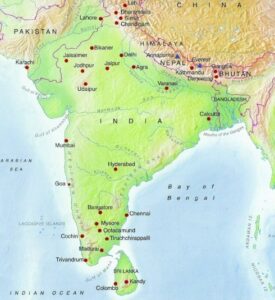Model Answer Introduction India possesses immense potential for solar energy, with an estimated availability of 4,000 trillion kWh per year. This renewable energy source is a key element of India’s energy strategy, with a target of generating 100 GW of solar power out of 175 GW of total renewable enRead more
Model Answer
Introduction
India possesses immense potential for solar energy, with an estimated availability of 4,000 trillion kWh per year. This renewable energy source is a key element of India’s energy strategy, with a target of generating 100 GW of solar power out of 175 GW of total renewable energy by 2022, as outlined in the Intended Nationally Determined Contributions (INDCs). Currently, India has an installed solar capacity of 43 GW (Source: Ministry of New and Renewable Energy).
Regional Variations
Ideal Regions for Solar Energy
The desert areas of Rajasthan and Kutch in Gujarat are prime locations for solar energy generation due to their barren lands and high insolation levels. These regions receive abundant sunlight throughout the year, making them ideal for large-scale solar projects.
Low Potential Areas
Conversely, the Himalayan and northeastern regions of India have lower potential for solar energy generation. These areas experience challenging terrain and lower insolation levels, which limit the feasibility of solar energy projects.
Moderate Regions
Coastal states, such as Kerala, exhibit moderate solar energy potential. The long monsoon season affects solar generation compared to states in the heartland of India, which generally receive more consistent sunlight.
Rooftop Solar Potential
Urban areas offer significant opportunities for rooftop solar installations. The rooftop solar panel program can substantially contribute to India’s solar energy goals, especially in metropolitan cities where space is limited.
Challenges to Solar Energy Development
Despite the potential, several challenges hinder the solar energy program in India:
- Overproduction can lead to very low tariff rates, discouraging investment in solar projects.
- Poor integration of solar energy with the grid and difficulties in land acquisition for solar parks present significant obstacles.
- Technological barriers exist, particularly the dependency on lithium imports from China for photovoltaic (PV) cells.
- Lack of awareness and financial constraints hinder rooftop solar installations.
Conclusion
The Indian government has initiated several policies to bolster the solar energy market, including the SARAL Index, PM KUSUM, and floating solar plants in Gujarat. With its low carbon footprint, solar energy holds the potential to replace conventional energy sources and help India meet its commitments under the INDCs and the Panchamrit proposals presented at COP 26. Addressing regional variations and challenges will be crucial for harnessing India’s solar energy potential effectively.
See less

Model Answer Introduction India’s forest cover is approximately 24.56% of its total geographical area, according to the India State of Forest Report 2019. However, the country has lost about 9.38 million hectares of forest cover between 1991 and 2019, raising concerns about environmental sustainabilRead more
Model Answer
Introduction
India’s forest cover is approximately 24.56% of its total geographical area, according to the India State of Forest Report 2019. However, the country has lost about 9.38 million hectares of forest cover between 1991 and 2019, raising concerns about environmental sustainability and climate change.
Status of Forest Resources
Mangrove Cover
Mangroves are crucial ecosystems that provide coastal protection, support biodiversity, and sequester carbon. India has around 4,975 square kilometers of mangrove cover, with the Sundarbans delta being the largest mangrove forest globally.
Bamboo Cover
Bamboo is a fast-growing renewable resource that plays a vital role in the economy and environment. India holds the largest area under bamboo cultivation in the world, covering approximately 2 million hectares.
Increase in Forest and Tree Cover
The total forest and tree cover in India increased by 13,000 square kilometers from 2017 to 2019, thanks to government initiatives like the Green India Mission and the National Agroforestry Policy.
Total Carbon Stock
Indian forests store around 7,124 million tonnes of carbon. Deforestation and degradation release significant amounts of carbon dioxide, contributing to global warming. Therefore, preserving and increasing forest cover is essential for climate change mitigation.
Impact on Climate Change
Forests serve as vital carbon sinks, absorbing carbon dioxide from the atmosphere. They also regulate local weather patterns, prevent soil erosion, and combat desertification. The degradation of forests exacerbates climate change by releasing stored carbon and reducing the land’s capacity to sequester more.
Vulnerability to Climate Change
India is particularly vulnerable to climate change due to its extensive coastline, dense population, and reliance on agriculture. The country faces extreme weather events, such as droughts and floods, which threaten food security and public health.
Conclusion
India’s forest resources are critical for mitigating climate change and providing ecological, economic, and social benefits. Protecting and enhancing these resources is vital for sustainable development and resilience against climate-related challenges.
See less